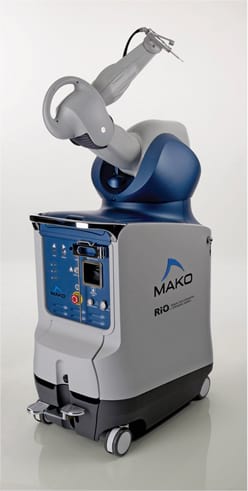FAQs about Makoplasty
What is MAKOplasty®?
MAKOplasty® Partial Knee Resurfacing is an innovative treatment option for adults living with early to midstage OA in the medial (inner), patellofemoral (top), or lateral (outer) compartments of the knee. It is powered by the RIO® Robotic Arm Interactive Orthopedic System, which allows for consistently reproducible precision in performing partial knee resurfacing.
During the procedure, the diseased portion of the knee is resurfaced, sparing the patient’s healthy bone and surrounding tissue. An implant is then secured in the joint to allow the knee to move smoothly again. MAKOplasty® Partial Knee Resurfacing can:
- Facilitate optimal implant positioning to result in a more natural feeling knee following surgery
- Result in a more rapid recovery and shorter hospital stay than traditional knee replacement surgery
- Be performed on an outpatient basis
- Promote a rapid relief from pain and return to daily activities
As a knee arthroplasty procedure, MAKOplasty® is typically covered by most Medicare-approved and private health insurers.
How does MAKOplasty® work?
The RIO® Robotic Arm Interactive Orthopedic System features three dimensional pre-surgical planning. During surgery, the RIO® provides the surgeon with real-time visual, tactile and auditory feedback to facilitate optimal joint resurfacing and implant positioning. It is this optimal placement that can result in more natural knee motion following surgery.
How may MAKOplasty® benefit me?

The Rio® Robot Arm Interactive System
Who would be a good candidate for the MAKOplasty® procedure?
Typically, MAKOplasty® patients share the following characteristics:
- Knee pain with activity, usually on the inner knee and/or under the knee cap, or the outer knee
- Start up knee pain or stiffness when activities are initiated from a sitting position
- Failure to respond to non-surgical treatments or nonsteroidal anti-inflammatory medication
If I undergo MAKOplasty®, what can I expect?
MAKOplasty® can be performed as either an inpatient procedure or on an outpatient basis depending on what your orthopedic surgeon determines is right for you. Hospital stays average anywhere from one to three days; ambulatory patients return home the same day.
In many cases, patients are permitted to walk soon after surgery, drive a car within two weeks and return to normal daily activities shortly thereafter.
What is the lifespan of a MAKOplasty® implant?
All implants have a life expectancy that depends on several factors including the patient’s weight, activity level, quality of bone stock and compliance with their physician’s orders.
Proper implant alignment and precise positioning during surgery are also very important factors that can improve the life expectancy of an implant. Through the use of RIO®, implants can be optimally aligned and positioned to ensure the longest benefit. RESTORIS® MCK implants enable the treatment of one or two compartments with OA disease. With single compartment disease, a second compartment may be treated in the future if OA spreads. In addition, because very little bone is actually removed during a MAKOplasty® procedure, the implants can be replaced with another procedure such as a total knee replacement, if necessary.